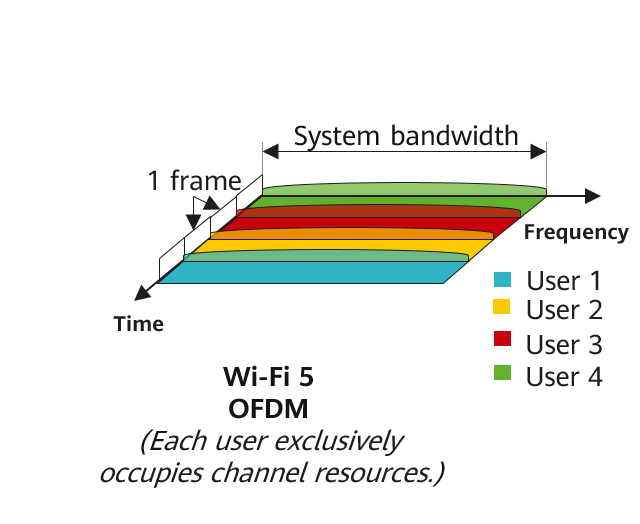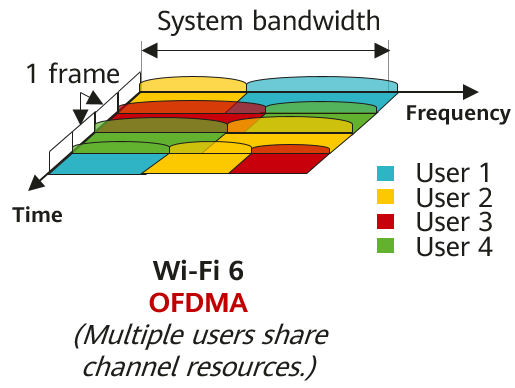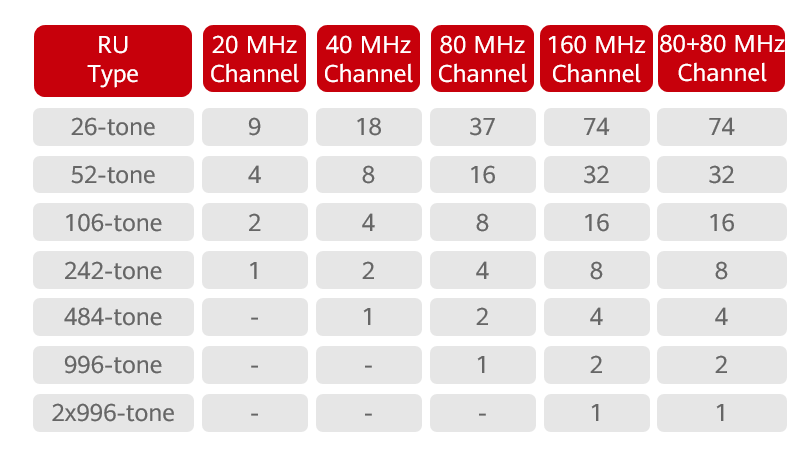What Is OFDMA?
Orthogonal Frequency Division Multiple Access (OFDMA) is a new technology introduced into Wi-Fi 6. It greatly improves the spectrum utilization and WLAN performance.
How Does OFDMA Work?
One of the key differences between Wi-Fi 6 and Wi-Fi 5 is that the former introduces the multi-user technology — OFDMA, which makes it possible for users to improve spectrum utilization by sharing channel resources.
Before Wi-Fi 6, the OFDM technology is used for data transmission, and users are distinguished based on time segments. In each time segment, one user occupies all subcarriers on a channel and sends a complete data packet, as shown in the following figure.

OFDM working mode
Wi-Fi 6 introduces a more efficient data transmission mode, that is, OFDMA. Wi-Fi 6 supports the uplink and downlink MU modes; therefore, this data transmission mode is also called MU-OFDMA. OFDMA allows multiple users to reuse channel resources by allocating subcarriers to different users and adding multiple access in the OFDM system. So far, this technology has been used by many wireless technologies, such as 3GPP LTE. In addition, the 802.11ax standard defines the smallest subchannel as a resource unit (RU), which includes at least 26 subcarriers and uniquely identifies a user. The resources of the entire channel are divided into small RUs with fixed sizes. In this mode, user data is carried on each RU. Therefore, on the total time-frequency resources, multiple users may simultaneously send data in each time segment, as shown in the following figure.

OFDMA working mode
Advantages of OFDMA over OFDM
OFDMA has the following advantages over OFDM:
- More refined channel resource allocation
Transmit power can be allocated based on channel quality, especially when the channel status of certain nodes is below standard. This can help allocate channel time-frequency resources in a more delicate manner.
- Better QoS
In Wi-Fi 5 and all earlier Wi-Fi standards, to transmit data, users occupy the entire channel. Therefore, a QoS data packet can be sent only after the current transmitter releases the entire channel, which leads to long latency. In the OFDMA mode, one transmitter occupies only some sources of the entire channel. Therefore, data of multiple users can be sent simultaneously, thereby reducing the data packet sending latency of QoS nodes.
- More concurrent users and higher user bandwidth
OFDMA divides the entire channel's resources into multiple subcarriers, which are then divided into several groups based on the RU type. Each user may occupy one or more groups of RUs to meet various bandwidth requirements. In Wi-Fi 6, the minimum RU size is 2 MHz and the minimum subcarrier bandwidth is 78.125 kHz. Therefore, the minimum RU type is 26-subcarrier RU. By analogy, there are 52-subcarrier RUs, 106-subcarrier RUs, 242-subcarrier RUs, 484-subcarrier RUs, and 996-subcarrier RUs. The following figure shows the maximum number of RUs at different channel bandwidths. A larger number of RUs indicates higher multi-user processing efficiency and higher throughput.
Number of RUs at different frequency bandwidths
OFDMA vs. MU-MIMO
Differences Between OFDMA and MU-MIMO
Both MU-MIMO and OFDMA can perform serial-to-parallel conversion to enable more efficient connectivity in multi-user scenarios, and they complement each other while also exhibiting unique characteristics.
- MU-MIMO: physically divides network resources to increase capacity and efficiency in high-bandwidth applications such as video streaming and downloading. This technology increases spatial stream utilization and effective bandwidth while lowering latency. However, the MU-MIMO system is not sufficiently stable and is prone to be impacted by STAs.
- OFDMA: supports multi-channel transmission in the frequency domain and is ideal for low-bandwidth, small-packet applications such as web browsing and instant messaging. It increases spatial stream utilization and transmission efficiency while reducing application latency and queuing time. Unlike MU-MIMO, this technology is stable and hard to be impacted by STAs.
Can MU-MIMO and OFDMA Be Used Together?
The answer is yes. There is no conflict between MU-MIMO and OFDMA. OFDMA and MU-MIMO joint scheduling optimally allocates resources based on services (such as web browsing, video streaming, downloading, and instant messaging). With a proper design of the MU-MIMO and OFDMA algorithms, Huawei Wi-Fi 6 APs use this joint scheduling mode to reduce the conflicts caused by random uplink/downlink access and enhance user experience in high-density access scenarios.
- Author: Zhou Xia
- Updated on: 2022-04-02
- Views: 25670
- Average rating:








